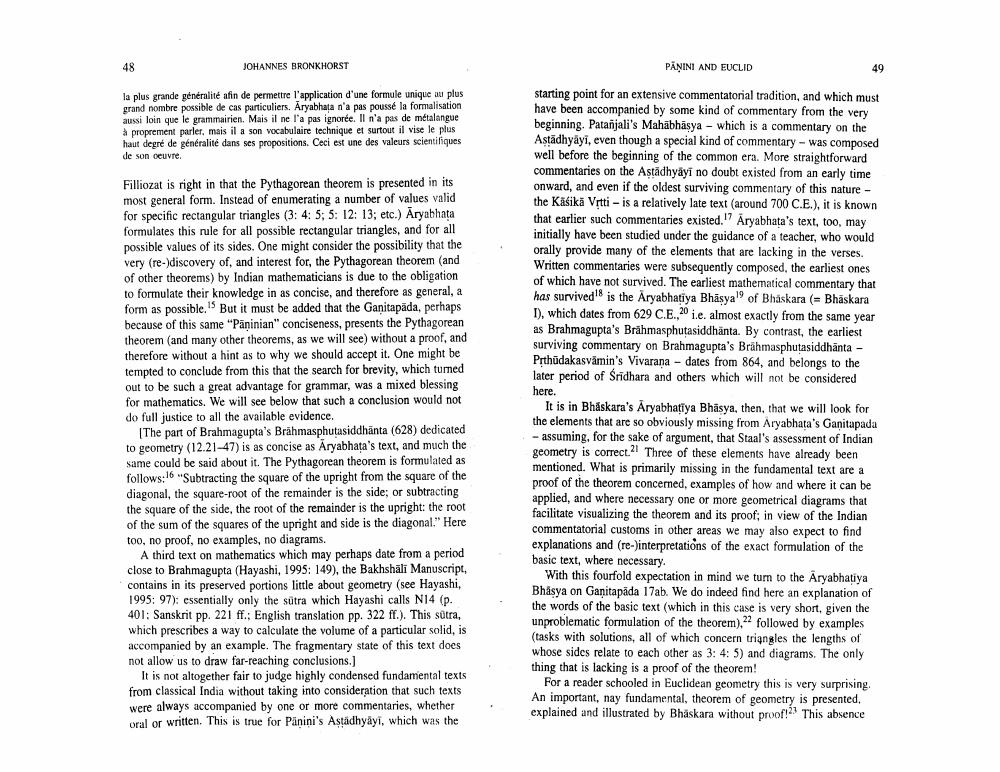Book Title: Panini And Euclid Reflections On Indian Geometry Author(s): Johannes Bronkhorst Publisher: Johannes Bronkhorst View full book textPage 4
________________ JOHANNES BRONKHORST PĀŅINI AND EUCLID la plus grande généralité afin de permettre l'application d'une formule unique au plus grand nombre possible de cas particuliers. Aryabhala n'a pas poussé la formalisation aussi loin que le grammairien. Mais il ne l'a pas ignorée. Il n'a pas de métalangue à proprement parler, mais il a son vocabulaire technique et surtout il vise le plus haut degré de généralité dans ses propositions. Ceci est une des valeurs scientifiques de son oeuvre Filliozat is right in that the Pythagorean theorem is presented in its most general form. Instead of enumerating a number of values valid for specific rectangular triangles (3: 4: 5; 5: 12: 13; etc.) Aryabhata formulates this rule for all possible rectangular triangles, and for all possible values of its sides. One might consider the possibility that the very (re)discovery of, and interest for, the Pythagorean theorem (and of other theorems) by Indian mathematicians is due to the obligation to formulate their knowledge in as concise, and therefore as general, a form as possible. But it must be added that the Ganitapada, perhaps because of this same "Paņinian" conciseness, presents the Pythagorean theorem (and many other theorems, as we will see) without a proof, and therefore without a hint as to why we should accept it. One might be tempted to conclude from this that the search for brevity, which tumed out to be such a great advantage for grammar, was a mixed blessing for mathematics. We will see below that such a conclusion would not do full justice to all the available evidence. The part of Brahmagupta's Brahmasphutasiddhanta (628) dedicated to geometry (12.21-47) is as concise as Aryabhata's text, and much the same could be said about it. The Pythagorean theorem is formulated as follows: Subtracting the square of the upright from the square of the diagonal, the square-root of the remainder is the side; or subtracting the square of the side, the root of the remainder is the upright: the root of the sum of the squares of the upright and side is the diagonal." Here too, no proof, no examples, no diagrams. A third text on mathematics which may perhaps date from a period close to Brahmagupta (Hayashi, 1995: 149), the Bakhshäli Manuscript contains in its preserved portions little about geometry (see Hayashi, 1995: 97): essentially only the sutra which Hayashi calls N14 (p. 401: Sanskrit pp. 221 ff.: English translation pp. 322 ff.). This sutra which prescribes a way to calculate the volume of a particular solid, is accompanied by an example. The fragmentary state of this text does not allow us to draw far-reaching conclusions.) It is not altogether fair to judge highly condensed fundamental texts from classical India without taking into consideration that such texts were always accompanied by one or more commentaries, whether oral or written. This is true for Panini's Astadhyayi, which was the starting point for an extensive commentatorial tradition, and which must have been accompanied by some kind of commentary from the very beginning. Patanjali's Mahābhāsya - which is a commentary on the Astädhyayi, even though a special kind of commentary - was composed well before the beginning of the common era. More straightforward commentaries on the Astādhyayi no doubt existed from an early time onward, and even if the oldest surviving commentary of this nature - the Kasika Vrtti - is a relatively late text (around 700 C.E.), it is known that earlier such commentaries existed." Aryabhata's text, too, may initially have been studied under the guidance of a teacher, who would orally provide many of the elements that are lacking in the verses. Written commentaries were subsequently composed, the earliest ones of which have not survived. The earliest mathematical commentary that has survived is the Aryabhatiya Bhäsyal of Bhaskara (= Bhaskara I), which dates from 629 C.E.,20 i.e. almost exactly from the same year as Brahmagupta's Brahmasphutasiddhanta. By contrast, the earliest surviving commentary on Brahmagupta's Brahmasphutasiddhanta - Prthudakasvamin's Vivarana - dates from 864, and belongs to the later period of Sridhara and others which will not be considered here. It is in Bhaskara's Aryabhatiya Bhasya, then, that we will look for the elements that are so obviously missing from Aryabhata's Ganitapada - assuming, for the sake of argument, that Staal's assessment of Indian geometry is correct.21 Three of these elements have already been mentioned. What is primarily missing in the fundamental text are a proof of the theorem concerned, examples of how and where it can be applied, and where necessary one or more geometrical diagrams that facilitate visualizing the theorem and its proof; in view of the Indian commentatorial customs in other areas we may also expect to find explanations and (re-)interpretations of the exact formulation of the basic text, where necessary. With this fourfold expectation in mind we turn to the Aryabhatiya Bhasya on Ganitapada 17ab. We do indeed find here an explanation of the words of the basic text (which in this case is very short, given the unproblematic formulation of the theorem)22 followed by examples (tasks with solutions, all of which concern triangles the lengths ol whose sides relate to each other as 3: 4: 5) and diagrams. The only thing that is lacking is a proof of the theorem! For a reader schooled in Euclidean geometry this is very surprising. An important, nay fundamental, theorem of geometry is presented. explained and illustrated by Bhaskara without proof:23 This absencePage Navigation
1 2 3 4 5 6 7 8 9 10 11 12 13 14 15 16 17 18 19 20
